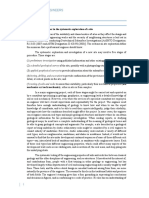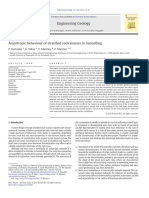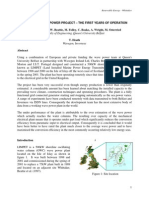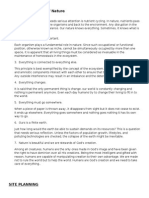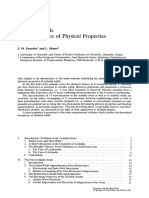0 ratings0% found this document useful (0 votes)
34 views15885.pollak Paper IAEG1998
15885.pollak Paper IAEG1998
Uploaded by
Uli AnwarThis document discusses how sedimentology studies can help improve engineering geology models for highway and tunnel construction projects in carbonate rock regions like Croatia. Sedimentological mapping and facies modeling were incorporated into exploration projects to better understand the depositional environments and properties of intact rock and rock masses. This provided insights into factors like layer thickness, textures, and discontinuity characteristics that influence engineering properties. Case studies demonstrated how sedimentological classifications and models enhanced geological profiles and predictions of rock mass behavior, aiding in project design and construction.
Copyright:
Attribution Non-Commercial (BY-NC)
Available Formats
Download as PDF, TXT or read online from Scribd
15885.pollak Paper IAEG1998
15885.pollak Paper IAEG1998
Uploaded by
Uli Anwar0 ratings0% found this document useful (0 votes)
34 views5 pagesThis document discusses how sedimentology studies can help improve engineering geology models for highway and tunnel construction projects in carbonate rock regions like Croatia. Sedimentological mapping and facies modeling were incorporated into exploration projects to better understand the depositional environments and properties of intact rock and rock masses. This provided insights into factors like layer thickness, textures, and discontinuity characteristics that influence engineering properties. Case studies demonstrated how sedimentological classifications and models enhanced geological profiles and predictions of rock mass behavior, aiding in project design and construction.
Original Title
15885.Pollak Paper IAEG1998
Copyright
© Attribution Non-Commercial (BY-NC)
Available Formats
PDF, TXT or read online from Scribd
Share this document
Did you find this document useful?
Is this content inappropriate?
This document discusses how sedimentology studies can help improve engineering geology models for highway and tunnel construction projects in carbonate rock regions like Croatia. Sedimentological mapping and facies modeling were incorporated into exploration projects to better understand the depositional environments and properties of intact rock and rock masses. This provided insights into factors like layer thickness, textures, and discontinuity characteristics that influence engineering properties. Case studies demonstrated how sedimentological classifications and models enhanced geological profiles and predictions of rock mass behavior, aiding in project design and construction.
Copyright:
Attribution Non-Commercial (BY-NC)
Available Formats
Download as PDF, TXT or read online from Scribd
Download as pdf or txt
0 ratings0% found this document useful (0 votes)
34 views5 pages15885.pollak Paper IAEG1998
15885.pollak Paper IAEG1998
Uploaded by
Uli AnwarThis document discusses how sedimentology studies can help improve engineering geology models for highway and tunnel construction projects in carbonate rock regions like Croatia. Sedimentological mapping and facies modeling were incorporated into exploration projects to better understand the depositional environments and properties of intact rock and rock masses. This provided insights into factors like layer thickness, textures, and discontinuity characteristics that influence engineering properties. Case studies demonstrated how sedimentological classifications and models enhanced geological profiles and predictions of rock mass behavior, aiding in project design and construction.
Copyright:
Attribution Non-Commercial (BY-NC)
Available Formats
Download as PDF, TXT or read online from Scribd
Download as pdf or txt
You are on page 1of 5
SEDIMENTOLOGY IN THE SERVICE OF ENGINEERING GEOLOGY:
STUDY OF SOME RESULTS OF THE EXPLORATIONS FOR HIGHWAY CONSTRUCTION AND
TUNNELING IN CROATIA
D. Pollak
Institute of Geology, Zagreb, Croatia
K. Braun
Institute of Geology, Zagreb, Croatia
ABSTRACT: Exploration for highway construction and tunneling in Croatia besides normal field
investigations, involved sedimentological survey. This paper presents results of laboratory and field
investigations which can improve our conclusions about rock mass quality. The authors encourage the
application of sedimentology in engineering geology, particularly in karstic regions, for more appropriate
understanding of the rock mass and intact rock. Introduction of sedimentological modelling into this project
indicates a great influence of sedimentology into engineering geology and it certainly enhanced our
engineering-geological model.
RESUM: Dans le cadre de la construction des routes et tunnels en Croatie, en plus des travaux de
reconnaissance usuels, ont t effectus aussi les essais sdimentologiques. Larticle prsente les rsultats des
essais en laboratoire et sur le terrain ayant amlior sensiblement lvaluation de la masse rocheuse.
Ladoption des modles sdimentologiques dans les projects de reconnaissance gotechnique, a dmontr,
spcialement dans la rgion karstique de la Croatie, une grande influence de la sdimentologie sur laspect et
sur la qualit du modle dingnirie gologique dfinitif.
INTRODUCTION
Sedimentary rocks are of considerable importance in
Croatia since they compose more than 90% of its
territory. At the central and southern part of the
country, most are carbonate rocks.
Increased planning, designing and constructing of
the highways in our country demanded thorough
investigations of certain areas. Since most
investigated areas are sedimentary rocks, mostly
carbonates, the investigations have been reconciled
to demand of nature. The authors idea was to cover
the investigated area with sedimentological
mapping, in addition to the usual complex field
investigations: photogeology, geological and
engineering-geological mapping, structural
measurements, refraction seismic, geoelectrics,
analytical research and data processing.
Therefore all of the sedimentological exploration
in the paper were directed towards limestone and
dolomite rock masses.
Since numerous sedimentation factors have a
great impact on geotechnical characteristics of rocks
(structure and texture, shape of the sediment body,
thickness of layers, mineral composition, diagenesis,
roughness of the bedding surfaces etc.), depositional
conditions and models should have an important
place in creating of engineering-geological models.
MODELS
To determine the properties of the intact rock and
rock mass, it is very important to know as much as
possible about its history. Its formation, genesis,
structure, texture and later transformation, alteration
and destruction are the basic processes which
determine properties of the rocks. The engineering
geologist should pay particular attention to this
when developing the model.
Classification of the intact rock
A very simplified classifications was used in the
course of basic geotechnical (engineering-
geological) description of rocks and rock masses.
Considering carbonate rocks, a more detailed
description was based on classification systems
given by Carozzi (1960) and Folk (1959). Both of
Figure 1. Classification of limestones based on depositional texture. After Dunham (1962) with modifications of Embry & Klovan.
From Tucker (1991).
classifications require microscopic determination of
the rock type. For engineering-geological practice,
following up the approach in sedimentological
investigations, classification proposed by Dunham
(1962) (Fig. 1) seems to be more convenient,
because it enables description of intact carbonate
rocks according to their depositional texture directly
in the field. Depositional textures, furthermore,
make it possible to recognize the depositional
environment defining facies transitions, disposal,
scale and persistence of certain rock types.
Importance of these factors in engineering-
geological modelling is paramount, since they define
diversity, appearance, shape, dimensions and
persistence of single lithological unit (Fig. 2) and
consequently, members of the engineering-
geological model.
Figure 2. Stages of reef growth. A sketch of the four divisions
of the reef-core facies with a tabulation of the most common
types of limestone, relative species diversity and shape of reef-
builders found in each stage. After Walker (1984).
Facies modelling in defining the engineering-
geological properties of rock masses is particularly
important, acting as a framework and guide in
prediction of rock mass engineering-geological and
geotechnical behavior, in certain circumstances (e.g.
in tunneling).
Sedimentological studies offer the possibility of
defining the regularities in deposition of important
or reference geotechnical members in the
lithostratigraphical sequences. In carbonate rocks,
belonging to the carbonate platform, low energy
intertidal sequences are very common, including a
transition from typical muddy to typical grainy ones
(Fig. 3).
Figure 3. Low energy intertidal. Two hypothetical sequences
with a low energy tidal flat unit developed on a low energy
subtidal unit (left) and high energy lime sand unit (right). After
Walker (1984).
Regularities of facies variations can be a
considerable aid in engineering and geotechnical
modelling and defining prognostic profiles, for
example in tunnel designing.
Sedimentological modelling was, recently, very
successfully applied in designing the tunnels
(Cicarija, 12.7 km and Velebit, 5.7 km) and
highway (Rijeka-Karlovac, 100 km) in Croatia. For
example, the Velebit tunnel area is of carbonate
rocks of the Adriatic Carbonate Platform ranging
from Middle Triassic, to the late Cretaceous.
Figure 4. Schematic geological column of the Velebit tunnel
area. After Maticec at al. (1997).
Main depositional environments are represented by
peritidal carbonate sediments (subtidal, intertidal
and less supratidal sedimentary deposits) (Fig. 4). In
that case detailed sedimentological classification of
the sedimentary rocks clearly shows correlation with
their engineering-geological properties. Exploration
enabled designing a very reliable geotechnical
profile which was checked while the excavation is in
progress.
Facies models, bedding and engineering geology
A layer is a geologic body separated from its
surrounding rock mass by a primary discontinuity. It
represents the consequence of changes of
granulometry, mineralogy, lithology, orientation or
pattern of particles or simply the termination of
sedimentation. In most cases it is external bedding,
represented with the upper and lower discontinuity
separating the layer from the next one.
Internal bedding is a textural or structural
property of the layer itself, and can be laminated,
crossed, parallel, undulated, graded etc.
Thickness and persistence of the layers can vary
vertically and laterally, and often depends on the
mechanism of the deposition and conditions of the
sedimentation.
The roughness of the bedding surfaces directly
influences engineering-geological properties of the
rock mass and can be influenced by rain drops,
ripple marks, turbiditic traces, rolling marks, sliding
marks etc.
There are also some chemical, biochemical and
diagenetic processes which can influence
geotechnical rock mass properties, like
stylolitization, bioturbation, recrystallization,
dolomitization, silicification, selective dissolution
and cataclasis.
For example, stylolitization can improve
roughness of certain discontinuity, but on the other
hand, it also very often contain clay mineral fill, and
rock with the a lot of stylolites separate easily.
If mica flakes are oriented parallel to the layer
itself, the discontinuities becomes slickenslided and
a separation of interlayers is much more likely. If
coarse-grained particles constitute the base of the
layer, they usually erode the fine grained top of the
lower bed, creating irregular bedding surfaces.
Sedimentological investigations, divide the
carbonate deposits into sedimentary sequences,
using appropriate knowledge to predict, for example,
the density of slickenslided primary discontinuities.
Obviously, higher density of such discontinuities
occurs in muddy parts of sequences (mudstones,
wackestones) of the intertidal or shallow subtidal
marine depositional environments.
Lithological type and strength of the intact rock
In clastic sedimentary rocks, physical properties of
the intact rock can be determined by strength of the
grains and their matrix. It is even possible to
calculate the theoretical strength of some rocks, but
they are far from being ideal materials, with many
irregularities in texture and structure. Our aim is not
to predict the exact value of some physical property
of the rock, but to place the rock mass on its right
group. Here it should be noted that the index of the
rock texture (m
i
), an important factor of the Hoek-
Brown failure criterion, depends generally on grain
size, but also on: particle texture (detrital, muddy or
skeletal); their fabric or ratio between the content of
particles and matrix (wackestone or packstone); kind
of matrix (micritic or sparitic); and degree of
recrystallization of the intact rock.
Strength of most of the sedimentary rocks
depends on characteristic of the matrix between the
particles, kind of particles and their bonds. For
example analysis of the uniaxial strength of
limestone indicated a higher strength of packstone
and grainstone than mudstone and wackestone.
A good example of this situation is the Upper
Triassic dolomite in the Gorski kotar region,
Croatia, covering more than 5 km of Zagreb to
Rijeka highway (and expected to be excavated in the
Velebit tunnel) (Fig. 5).
25
50
75
100
150
200
0
1
2
3
4
f
r
e
q
u
e
n
c
y
qu / MPa
Stromatolite dolomite
25
50
75
100
150
200
0
2
4
6
8
10
12
14
f
r
e
q
u
e
n
c
y
qu / MPa
Crystalline dolomite
Figure 5. Uniaxial strength of stromatolite and crystalline
dolomite at the core samples.
The dolomite is represented by coarse crystalline
dolomite and interlayers of stromatolitic dolomite.
Stromatolite dolomite represents about 10-20% of
the dolomite mass. With a lower uniaxial strength
and laminated texture it interrupted the homogeneity
of the rest of the rock having higher uniaxial
strength. Distinction between crystalline and
stromatolite dolomite was simple, so the
homogeneity and anisotropy could be established by
measurements of visible bed thickness.
Different textural rock types which occurred in
investigated highway and tunnels in Croatia, have
variable uniaxial strength. The differences, related to
the different varieties of limestones, can be seen in
the following tables (Table 1 and Table 2).
Table 1.
LIMESTONES
uniaxial
strength / MPa
ultrasonic
waves mean /
(m/s)
texture (num. of samples) mean range
v
p
v
s
MUDSTONE (163) 119 70-169 5800 2584
PACKSTONE (16) 136 89-183 6129 2862
INTRABAS.BRECC.(13
)
117 57-177 5217 2382
Table 2.
DOLOMITES
uniaxial
strength / MPa
ultrasonic
waves mean /
(m/s)
texture (num. of samples) mean range
v
p
v
s
CRYSTALLINE (46) 85 39-131 3853 2002
STROMATOLITE (8) 43 26-60 3977 2194
Facies model and sampling
In creation of an engineering-geological model it is
vital to have valid quantification of the data. It is
often a challenging problem to evaluate the impact
of different factors to the rock mass. Consequently,
the most important is that the sample taken for
analysis have to be representative of the rock mass.
As carbonate rocks are product of sedimentation
under various conditions, each textural type should
be recognized in the field and placed in correlation
with sedimentary sequences or their parts. The
establishment of the sedimentological model that
includes a determination of depositional
environment of the investigated area, dimension,
shape and persistence of rock types with equal or
similar mechanical and geotechnical characteristics,
allows establishment of a reliable engineering-
geological model. Only reliable engineering-
geological models can act as an appropriate input for
successful geotechnical modelling and designing,
particularly in tunneling and highway construction.
Therefore, more detailed classification of the
sediment type and determination of depositional
conditions, seems to be fundamental and effective in
engineering-geological modelling.
CONCLUSION
Sedimentological modelling was recently and
successfully applied in designing the tunnels
(Cicarija and Velebit) and highway (Rijeka-
Karlovac), in Croatia.
Basic properties of sedimentary rocks normally
determine engineering-geological properties of the
rocks. Impact of these factors on geotechnical
properties of the rocks should be evaluated by the
engineering geologist.
In engineering-geological practice, following the
approach in sedimentological investigations, the
Dunham (1962) classification of limestone modified
by Embry and Clovan was used. It enables
description of intact carbonate rocks according to
their depositional texture directly in the field.
Depositional textures, furthermore, enable
recognition of the depositional environment,
defining facies transitions, disposal, scale and
persistence of certain rock types.
Facies models furthermore act as a framework
and guide in the prediction of rock mass
engineering-geological and geotechnical behavior.
Geometry of sedimentary bodies, thickness and
persistence of the layers, roughness and other
characteristics of primary discontinuities, directly
influence engineering properties of rock masses, and
depend on condition of depositional environment.
The strength and rock texture index (m
i
) in most
of the sedimentary rocks is the consequence of grain
size, particle varieties and fabric, matrix between the
particles and their bonds. Analysis of uniaxial
strength of limestone indicated higher strength of
packstone and grainstone than mudstone,
wackestone and rudstone. Also crystalline dolomite
is stronger than stromatolite ones.
Prompt establishment of the sedimentological
model, linking rock types with the equal or similar
mechanical and geotechnical characteristics (using
Dunhams classification of carbonate rocks), allows
the establishment of the appropriate and reliable
engineering-geological model. It enables also the
appropriate sampling according to the diversity,
mode of appearance, shape, dimensions and
persistence, defined in the frame of facies model.
Therefore, more detailed classification of the
sediment type and determination of sedimentation
conditions already in the field, seems to be
fundamental and effective in engineering-geological
modelling.
REFERENCES
Braun, K.; Pollak, D.; Mlinar. Z. (1995): Engineering-
geological Modelling. 1. Croatian Geological
Congress, Proceedings, vol. 1, 125-131, Opatija.
Carozzi, A. V. (1960): Microscopic Sedimentary
Petrography. John Wiley & Sons, Inc., New
York-London.
Dunham, R. J. (1962): Classification of carbonate
rocks according to depositional texture. From:
classification of carbonate rocks (Ham, W. E.,
Amer. Assoc. Petrol. Geol. Mem., 1.
Folk, R. L. (1959): Practical petrographic
classification of limestones. Bull. Amer. Assoc.
Petrol. Geol., 1-38.
Hoek, E. (1995): Strength of Rock & Rock Masses.
ISRM News Journal, vol. 2 (No 2), 4-17,
Lisaboa.
Hoek, E.; Kaiser, P.K.; Bawden, W.F. (1995):
Support of Underground Excavations in Hard
Rock. A.A. Balkema, Rotterdam.
Tucker, M. E. (1991): Sedimentary Petrology.
Blackwell Scientific Publications, Oxford.
Maticec, D.; Fucek, L.; Ostric, N.; (1997): Tunnel
Velebit-Geotechnical report; Sedimentological
investigations. Professional report, Institute of
Geology, arch. no. 63/97
Walker, R. G. (1984): Facies Models. Geoscience
Canada, Second Edition, Ainsworth Press
Limited, Kitchener, Ontario.
You might also like
- Rock Mechanics Lecture MaterialDocument97 pagesRock Mechanics Lecture MaterialKarthik100% (8)
- Andreas MalmDocument4 pagesAndreas MalmHelping HandNo ratings yet
- 11 - Engineering Geology and Soil Mechanics - Chapter 12 - Common Usage of Rock and Uncemented SedimentDocument40 pages11 - Engineering Geology and Soil Mechanics - Chapter 12 - Common Usage of Rock and Uncemented Sedimenthessian123100% (2)
- Seismic Slope Stebility Analysis of Jointed Rock Masses On The Northern Abutment of Gotvand Dam, IranDocument8 pagesSeismic Slope Stebility Analysis of Jointed Rock Masses On The Northern Abutment of Gotvand Dam, Iranalonso_msnNo ratings yet
- Corominas Et All 2014Document20 pagesCorominas Et All 2014Delia PlăcintăNo ratings yet
- 1 s2.0 S0886779817306028 MainDocument19 pages1 s2.0 S0886779817306028 MainMahmud DawudNo ratings yet
- Lao Et Al. - 2020 - Characteristics of Growth Fault Architecture and Its Evolution in MudstoneDocument16 pagesLao Et Al. - 2020 - Characteristics of Growth Fault Architecture and Its Evolution in Mudstonethảo nguyễnNo ratings yet
- Designing Constructing and Monitoring of Slopes inDocument7 pagesDesigning Constructing and Monitoring of Slopes inDr Bali ReddyNo ratings yet
- ESaunders ALeRiche TShapkaFels WBarnett CharacterisationFoliatedRock - 202020200813092128177Document16 pagesESaunders ALeRiche TShapkaFels WBarnett CharacterisationFoliatedRock - 202020200813092128177Jhony Wilson Vargas BarbozaNo ratings yet
- Rock Mass ClassificationDocument21 pagesRock Mass ClassificationAze100% (2)
- TunnelingDocument14 pagesTunnelinggerearegawi721No ratings yet
- GeomechanicalInvestigations ForArchitecturalHeritage EgyptDocument10 pagesGeomechanicalInvestigations ForArchitecturalHeritage EgyptVorenas LoayzaNo ratings yet
- The Geological ModelDocument12 pagesThe Geological ModelMichael AltamiranoNo ratings yet
- s10064 015 0719 8Document13 pagess10064 015 0719 8Farheen ShafiqueNo ratings yet
- Report of Group 6 NotesDocument11 pagesReport of Group 6 NotesEldie Junior ApostolNo ratings yet
- AAPG - Seismic Interpretation of Cabonate Depositional EnvironenmentsDocument17 pagesAAPG - Seismic Interpretation of Cabonate Depositional EnvironenmentsNGT56No ratings yet
- Carbonate Cementation - Sequence Strat Framework - TaylorDocument13 pagesCarbonate Cementation - Sequence Strat Framework - TaylorJohnSandovalNo ratings yet
- Petro1 2Document14 pagesPetro1 2Teresa FofaNo ratings yet
- Geotechnical Problems Encountered in Road Construction in The Karst Areas in Dalmatia PDFDocument7 pagesGeotechnical Problems Encountered in Road Construction in The Karst Areas in Dalmatia PDFNovia SetyaNo ratings yet
- RocksDocument71 pagesRocksBikash ChaudharyNo ratings yet
- RMR GSI 2021 Applsci-11-03351-V2Document13 pagesRMR GSI 2021 Applsci-11-03351-V2ali basyaNo ratings yet
- Textural and Geochemical Micro-Analysis in The Interpretation of Clay Mineral Characteristics" Lessons From Sandstone Hydrocarbon ReservoirsDocument13 pagesTextural and Geochemical Micro-Analysis in The Interpretation of Clay Mineral Characteristics" Lessons From Sandstone Hydrocarbon ReservoirsTri Nguyen NgocNo ratings yet
- Perras Diederichs 2011 CGS ClassificationDocument9 pagesPerras Diederichs 2011 CGS ClassificationMAbdulYazifaMNo ratings yet
- GEOLOGY FOR ENGINEERS - Introduction and Physical GeologyDocument16 pagesGEOLOGY FOR ENGINEERS - Introduction and Physical GeologyDum AccountNo ratings yet
- Research Article: Weathering Influence On Properties of Siltstones From Istria, CroatiaDocument16 pagesResearch Article: Weathering Influence On Properties of Siltstones From Istria, CroatiaEva IndrianiNo ratings yet
- Skalinski & Kenter (2015) - Carbonate Petrophysical Rock TypingDocument31 pagesSkalinski & Kenter (2015) - Carbonate Petrophysical Rock TypingAmine BoucedraNo ratings yet
- Queens Tunnel - Reduced PeDocument21 pagesQueens Tunnel - Reduced Pe2sangjun75No ratings yet
- Rippability of RocksDocument4 pagesRippability of RocksAnonymous pFXVbOS9TWNo ratings yet
- Correlation Between Rock Fabrics and Physical Properties of Carbonate Reservoir RocksDocument17 pagesCorrelation Between Rock Fabrics and Physical Properties of Carbonate Reservoir RocksdiditkusumaNo ratings yet
- NanopetrologyDocument51 pagesNanopetrologynataliaimeldawNo ratings yet
- An Excavatability Classification System For Surface Excavation in Sedimentary RocksDocument11 pagesAn Excavatability Classification System For Surface Excavation in Sedimentary RocksZuhaib ShaikhNo ratings yet
- Muldoon@uwosh - Edu: Background - Effect of Fractures On Groundwater Flow PatternsDocument4 pagesMuldoon@uwosh - Edu: Background - Effect of Fractures On Groundwater Flow PatternsDeesty OkktavianyNo ratings yet
- Unesco - Eolss Sample Chapters: Characterization of Geologic MaterialsDocument12 pagesUnesco - Eolss Sample Chapters: Characterization of Geologic MaterialsHaider ShahNo ratings yet
- 1111 MergedDocument12 pages1111 MergedMA. ANGELINE GRANADANo ratings yet
- Rock Masses As Construction Material-1Document10 pagesRock Masses As Construction Material-1Daljeet SidhuNo ratings yet
- Investigation of Geotechnical Parameters PDFDocument8 pagesInvestigation of Geotechnical Parameters PDFDian PageNo ratings yet
- Deformation Failure and Permeability of Coal Bearing Strata During Longwall Mining 2016 Engineering GeologyDocument12 pagesDeformation Failure and Permeability of Coal Bearing Strata During Longwall Mining 2016 Engineering Geologykatta_sridharNo ratings yet
- Applied Engineering GeologyDocument37 pagesApplied Engineering GeologykayNo ratings yet
- Integrated Geophysical and Geological Investigations Applied To Sedimentary Rock Mass CharacterizationDocument12 pagesIntegrated Geophysical and Geological Investigations Applied To Sedimentary Rock Mass CharacterizationAndres Puerta MejíaNo ratings yet
- Sen - 19-23Document5 pagesSen - 19-23awangdocsNo ratings yet
- Unit 2 - Rock Mass ClassificationDocument57 pagesUnit 2 - Rock Mass ClassificationAyush tiwariNo ratings yet
- Stockholm Bypass MWDDocument10 pagesStockholm Bypass MWDСемён УсNo ratings yet
- RockMechanicsII PDFDocument156 pagesRockMechanicsII PDFVincent EbinNo ratings yet
- Weathering Profiles of Some Sandstones From Sunshine Coast, Australia - Morphological and Geotechnical ApproachDocument9 pagesWeathering Profiles of Some Sandstones From Sunshine Coast, Australia - Morphological and Geotechnical ApproachVictor Henrique OliveiraNo ratings yet
- 1application & Objectives of Rock MechanicsDocument25 pages1application & Objectives of Rock MechanicsSheshu Babu100% (4)
- Skema Jawapan - Final Sem 2 Sesi 1617Document9 pagesSkema Jawapan - Final Sem 2 Sesi 1617Jacksmith LdreckssonNo ratings yet
- Identifications and Clasifications of Clay Shale Oke BanaDocument30 pagesIdentifications and Clasifications of Clay Shale Oke BanarullyirwandiNo ratings yet
- Tra Ducci OnDocument19 pagesTra Ducci OnNEPTALISNo ratings yet
- Geotechnical and Geomechanical Characteristics of The Rocks Along Tunnel of Kulekhani III Hydro-Electric ProjectDocument12 pagesGeotechnical and Geomechanical Characteristics of The Rocks Along Tunnel of Kulekhani III Hydro-Electric ProjectPravash DevkotaNo ratings yet
- Scal 2000 CarbonatesDocument10 pagesScal 2000 CarbonatesEzio Araujo100% (1)
- Rock Mechanics Advances of Underground Construction and MiningDocument15 pagesRock Mechanics Advances of Underground Construction and Miningdiana cristina arias aldanaNo ratings yet
- Stück Petrograph Petrophysical Material Quality Envir Earth Sci 2013Document34 pagesStück Petrograph Petrophysical Material Quality Envir Earth Sci 2013Clovis GonzattiNo ratings yet
- Bolla 2020Document18 pagesBolla 2020MARCOS ABRAHAM ALEJANDRO BALDOCEDA HUAYASNo ratings yet
- Anisotropic Behaviour of Stratified Rock Masses in TunnellingDocument10 pagesAnisotropic Behaviour of Stratified Rock Masses in TunnellingYérika LópezNo ratings yet
- 1 s2.0 S1365160900000265 MainDocument10 pages1 s2.0 S1365160900000265 Mainmanumigh793coolNo ratings yet
- 03z-2001 Paper ASEGE PDFDocument10 pages03z-2001 Paper ASEGE PDFWulan Dwikusuma AsihNo ratings yet
- Classification and Rippability of DuricrustsDocument13 pagesClassification and Rippability of DuricrustsBajocarNo ratings yet
- Sedimentary Petrology: An Introduction to the Origin of Sedimentary RocksFrom EverandSedimentary Petrology: An Introduction to the Origin of Sedimentary RocksRating: 4.5 out of 5 stars4.5/5 (3)
- Reconstructing Archaeological Sites: Understanding the Geoarchaeological MatrixFrom EverandReconstructing Archaeological Sites: Understanding the Geoarchaeological MatrixNo ratings yet
- Geothermal Energy and Its Scope in Bangladesh: Conference PaperDocument6 pagesGeothermal Energy and Its Scope in Bangladesh: Conference PaperMD. MAHFUGE RAHMAN TAMIMNo ratings yet
- Worksheet - 8 - Basic Chemistry - All ChaptersDocument4 pagesWorksheet - 8 - Basic Chemistry - All Chapterstax.amit1988No ratings yet
- Batangas Solar Farm PDS DraftDocument15 pagesBatangas Solar Farm PDS Draftjeicg21No ratings yet
- Experiment 5 CHM258Document5 pagesExperiment 5 CHM258MUHAMMAD AMIRUL FITRI AB RAZAKNo ratings yet
- Wayanadhill ResortDocument24 pagesWayanadhill ResortsainarmithatumuNo ratings yet
- Cloze Test: Practice Problems - 1: Check Your Proficiency Level in Cloze TestsDocument3 pagesCloze Test: Practice Problems - 1: Check Your Proficiency Level in Cloze TestsRaghavendra SharmaNo ratings yet
- Sustainability in India Through Wind: A Case Study of Muppandal Wind Farm in IndiaDocument19 pagesSustainability in India Through Wind: A Case Study of Muppandal Wind Farm in IndiaMukesh KumarNo ratings yet
- Name: - : 1. Complete The Table BelowDocument10 pagesName: - : 1. Complete The Table BelowChrise RajNo ratings yet
- Foresight Study Energy TransitionDocument33 pagesForesight Study Energy Transitionconvinced.elephant.iapvNo ratings yet
- Human Activity Has Had A Negative Impact On Plants and Animals Around The WorldDocument2 pagesHuman Activity Has Had A Negative Impact On Plants and Animals Around The WorldPhạm NguyệtNo ratings yet
- LimpetDocument8 pagesLimpetJoão AlvesNo ratings yet
- m02 PhysicsDocument213 pagesm02 PhysicsCanio NoceNo ratings yet
- 7 Laws of Nature (Lecture Notes by Arch't Ryan Cabanlit)Document4 pages7 Laws of Nature (Lecture Notes by Arch't Ryan Cabanlit)Mark HisolerNo ratings yet
- Chapter 9 Climate ChangeDocument12 pagesChapter 9 Climate Changejieeniola1No ratings yet
- Reading Comprehension Guide With Expected Questions - CompressedDocument16 pagesReading Comprehension Guide With Expected Questions - Compressedgamelurplay100% (1)
- Actinides - Chemistry and Phys. Properties - Structure & Bonding v.59 (1985) Pp.1-298Document296 pagesActinides - Chemistry and Phys. Properties - Structure & Bonding v.59 (1985) Pp.1-298ПлейнNo ratings yet
- Domains and Kingdoms: Study GuideDocument6 pagesDomains and Kingdoms: Study GuideosamaNo ratings yet
- 12 ABM InsulationMass Top WoolDocument1 page12 ABM InsulationMass Top Woolvin hoNo ratings yet
- Bavaria SolarparkDocument2 pagesBavaria Solarparkyoshitoma100% (9)
- Sedimentary RocksDocument11 pagesSedimentary RockschriztellseseNo ratings yet
- Notes For Final Exam About Information AgeDocument43 pagesNotes For Final Exam About Information AgeFirmalan Jacobine Marie F.No ratings yet
- Ce F243 1193Document2 pagesCe F243 1193YATHARTH AGARWALNo ratings yet
- Physical Sciences TestDocument1 pagePhysical Sciences TestMD. TasneemNo ratings yet
- Race ElementsDocument346 pagesRace ElementsAntonio SoaresNo ratings yet
- New Literacies Across The Curriculum Roger P. Ramos, Ed Professor Tuesday and Thursday-5:00 PM To 7:00 PM Date: March 2022 5:00 PM To 7:00 PMDocument13 pagesNew Literacies Across The Curriculum Roger P. Ramos, Ed Professor Tuesday and Thursday-5:00 PM To 7:00 PM Date: March 2022 5:00 PM To 7:00 PMAlyssa Jane PabloNo ratings yet
- Learning Objectives: Describe What Friction Is. (S6Fe-Iiia-C-1) Q3W1D1Document21 pagesLearning Objectives: Describe What Friction Is. (S6Fe-Iiia-C-1) Q3W1D1Gelyn Torrejos Gawaran100% (2)
- I. Listen and Fill in The Missing Information. (10 Points) BackgroundDocument11 pagesI. Listen and Fill in The Missing Information. (10 Points) Background32.Nguyễn Thị Minh Trang - 8ANo ratings yet
- Surse Pentru Referinte BibliograficeDocument2 pagesSurse Pentru Referinte BibliograficeLavinia Barbu100% (1)
- Analysis of Green Open Space Needs in Surabaya CityDocument4 pagesAnalysis of Green Open Space Needs in Surabaya CityDesra DesraNo ratings yet























